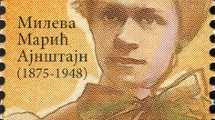Abstract
Soon after its appearance in 1905, the Einsteinian relativity with its relativistically admissible 3-velocities was recognized by Vladimir Varičak in 1908 as the realization in physics of the hyperbolic geometry of Bolyai and Lobachevski. At the same time, however, during the years 1907–1909 Minkowski reformulated the Einsteinian relativity in terms of a space of 4-velocities that now bears his name. As a result, the special theory of relativity that we find in the mainstream literature is not the one originally formulated by Einstein but, rather, the one reformulated by Minkowski. Thus, in particular, one of the most powerful ideas of Einstein in 1905, the Einstein addition of relativistically admissible 3-velocities that need not be parallel, is unheard of in most texts on relativity physics. Following our recently published book, Beyond the Einstein Addition, Law and its Gyroscopic Thomas Precession: The Theory of Gyrogroups and Gyrovector Spaces [1], the aim of this article is to employ the principle of pre-established harmony between mathematics and physics to demonstrate that the original Einsteinian relativity, as opposed to the Minkowskian relativity, is the legitimate formulation of special relativity whose time has returned.
Similar content being viewed by others
REFERENCES
A. A. Ungar, Beyond the Einstein Addition Law and its Gyroscopic Thomas Precession: The Theory of Gyrogroups and Gyrovector Spaces (Kluwer Academic, Dordrecht, 2001).
L. Pyenson, “Relativity in late Wilhelmian Germany: The appeal to a preestablished harmony between mathematics and physics,” Arch. Hist. Exact Sci., 27(2), 137-159 (1982).
V. Varičak, “Beiträge zur nichteuklidischen geometrie [Contributions to non-Euclidean geometry],” Jber. dtsch. Mat. Ver., 17, 70-83 (1908).
V. Varičak, “Anwendung der Lobatschefskjschen Geometrie in der Relativtheorie,” Phys. Z. 11, 93-96 (1910).
V. Varičak, Darstellung der Relativitätstheorie im dreidimensionalen Lobatchefskijschen Raume [Presentation of the Theory of Relativity in the Three-Dimensional Lobachevskian Space]. (Zaklada, Zagreb, 1924).
J.-L. Chen and A. Ungar, “The Bloch gyrovector,” Found. Phys. 32(4) 531-565 (2002).
J.-L. Chen and A. A. Ungar, “Introducing the Einstein metric to quantum computation and quantum information geometry,” Found. Phys. Lett. 15(2) 189-197 (2002).
A. A. Ungar, “The hyperbolic geometric structure of the density matrix for mixed-state qubits,” Found. Phys. 32(11), 1-29 (2002).
C. Lanczos, Space Through the Ages. The Evolution of Geometrical ideas from Pythagoras to Hilbert and Einstein (Academic, London, 1970).
A. Einstein, “Zur Elektrodynamik Bewegter Körper [On the electrodynamics of moving bodies],” Ann. Phys. (Leipzig) 17, 891-921 (1905).
A. Einstein, Einstein's Miraculous Years: Five Papers that Changed the Face of Physics (Princeton University Press, Princeton, 1998), edited and introduced by John Stachel. Includes bibliographical references, Einstein's dissertation on the determination of molecular dimensions, Einstein on Brownian motion, Einstein on the theory of relativity, Einstein's early work on the quantum hypothesis: a new English translation of Einstein's 1905 paper appears on pp. 123–160.
S. Walter, “The non-Euclidean style of Minkowskian relativity,” in The Symbolic Universe, Jeremy J. Gray, ed. (Oxford University Press, Oxford, 1999), pp. 91-127.
J. F. Barrett, “Special relativity and hyperbolic geometry,” in Proceedings, Physical Interpretations of Relativity Theory, London, UK 11–14 September 1998 (University of Sunderland, Sunderland, 1998).
L. Corry, “The influence of David Hilbert and Hermann Minkowski on Einstein's views over the interrelation between physics and mathematics,” Endeavor 22(3), 95-97 (1998).
H. Schmidt, Review of A. A. Ungar, Beyond the Einstein addition law and its gyroscopic Thomas precession, Zbl. Math. 0972.83002 (2001).
G. Gibbons, Review of A. A. Ungar, Beyond the Einstein Addition Law and its Gyroscopic Thomas Precession, The Observatory 121, 394 (2001).
V. Fock, The Theory of Space, Time and Gravitation (Macmillan, New York, 1964), 2nd revised edition, translated from the Russian by N. Kemmer.
H. Bacry, Lectures on Group Theory and Particle Theory (Gordon & Breach, New York, 1977), documents on modern physics.
R. U. Sexl and H. K. Urbantke, Relativity, Groups, Particles (Springer, Vienna, 2001) (special relativity and relativistic symmetry in field and particle physics), revised and translated from the 3rd German (1992) edn. by H. K. Urbantke.
S. Walter, Review of A. A. Ungar, Beyond the Einstein Addition Law and its Gyroscopic Thomas Precession, Found. Phys. Lett. 32(2), 327-330 (2002).
C. B. van Wyk, “Lorentz transformations in terms of initial and final vectors,” J. Math. Phys. 27(5), 1311-1314 (1986).
F. R. Halpern, Special Relativity and Quantum Mechanics (Prentice-Hall, Englewood Cliffs, 1968).
A. A. Ungar, “Applications of hyperbolic geometry in relativity physics,” in A. Prekopa, E. Kiss, Gy. Staar and J. Szenthe, eds., Janos Bolyai Memorial Volume (Vince, Budapest, 2002).
H. Goldstein, Classical Mechanics. 2nd edn. (Addison-Wesley, Reading, MA, 1980).
A. A. Ungar, “Thomas rotation and the parametrization of the Lorentz transformation group,” Found. Phys. Lett. 1(1), 57-89 (1988).
L. Silberstein, The Theory of Relativity (MacMillan, London, 1914).
E. Cunningham, The Principle of Relativity (University Press, Cambridge, 1914).
M. v. Laue, Das Relativitatsprinzip (Vieweg, Braunschweig, 1911).
M. B. Weinstein, Die Physik der bewegten Materie und die Relativitatstheorie (Barth, Leipzig, 1913).
M. Rivas, “Classical relativistic spinning particles,” J. Math. Phys. 30(2), 318-329 (1989).
E. Wigner, “On unitary representations of the inhomogeneous lorentz group,” Ann. Math. 40, 149-204 (1939).
D. Vassiliadis, “Wigner's little group and decomposition of Lorentz transformations,” J. Math. Phys. 30(9), 2177-2180 (1989).
Y. S. Kim and M. E. Noz, Theory and Applications of the Poincaré Group (Reidel, Dordrecht, 1986).
M. H. L. Pryce, “The mass-centre in the restricted theory of relativity and its connexion with the quantum theory of elementary particles,” Proc. Roy. Soc. London. Ser. A. 195, 62-81 (1948).
J. L. Synge, Relativity: The Special Theory (North-Holland, Amsterdam, 1956).
W. Rindler, Essential Relativity: Special, General, and Cosmological (Springer, New York, 1977).
W. Rindler, Introduction to Special Relativity (Clarendon Oxford, 1982).
D. Hestenes, New Foundations for Classical Mechanics, 2nd edn. (Kluwer Academic, Dordrecht, 1999).
M. Hausner, A Vector Space Approach to Geometry (Dover, New York, 1998), reprint of the 1965 original.
Author information
Authors and Affiliations
Rights and permissions
About this article
Cite this article
Ungar, A.A. On the Appeal to a Pre-Established Harmony Between Pure Mathematics and Relativity Physics. Found Phys Lett 16, 1–23 (2003). https://doi.org/10.1023/A:1024136905975
Published:
Issue Date:
DOI: https://doi.org/10.1023/A:1024136905975




